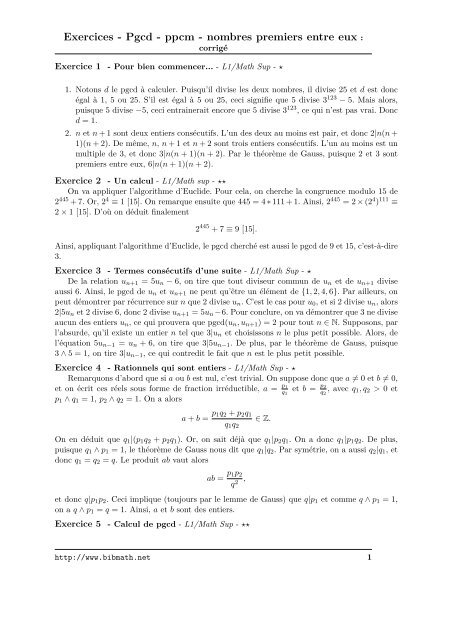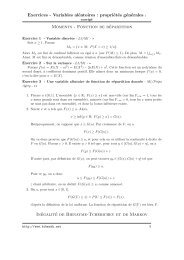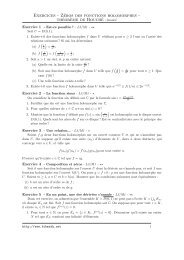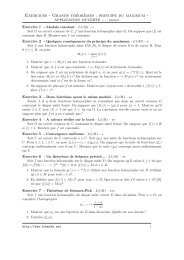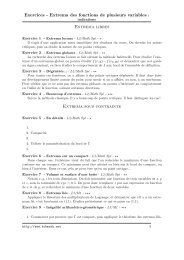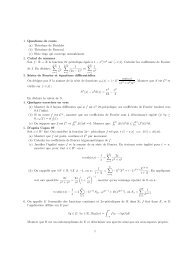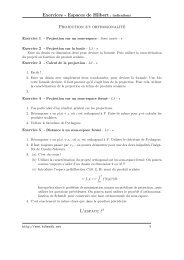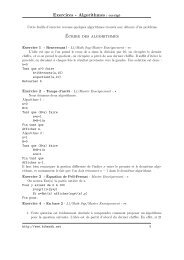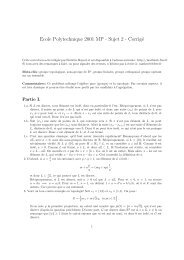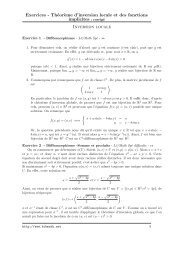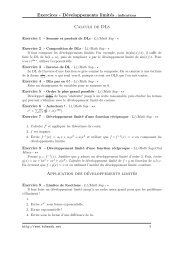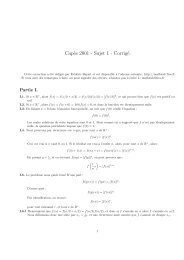Exercices - Pgcd - ppcm - nombres premiers entre eux : - Bibmath
Exercices - Pgcd - ppcm - nombres premiers entre eux : - Bibmath
Exercices - Pgcd - ppcm - nombres premiers entre eux : - Bibmath
You also want an ePaper? Increase the reach of your titles
YUMPU automatically turns print PDFs into web optimized ePapers that Google loves.
<strong>Exercices</strong> - <strong>Pgcd</strong> - <strong>ppcm</strong> - <strong>nombres</strong> <strong>premiers</strong> <strong>entre</strong> <strong>eux</strong> :corrigéExercice 7 - - L1/Math Sup - ⋆⋆1. On écrita = p α 11 . . . pαr r , b = p β 11 . . . pβr r , c = p γ 11 . . . pγr r .La condition c|ab signifie que γ j ≤ α j + β j pour tout j. De plus, on aa ∧ c = p min(α 1,γ 1 )1 . . . p min(αr,γr)rb ∧ c = p min(β 1,γ 1 )1 . . . p min(βr,γr)ret donc on a c|(a ∧ c)(b ∧ c) si et seulement si, pour tout j de 1, . . . , r, on aγ j ≤ min(α j , γ j ) + min(β j , γ j ).Mais si min(α j , γ j ) = γ j ou min(β j , γ j ) = γ j , c’est trivial. Sinon on apar hypothèse. Ceci prouve le résultat.min(α j , γ j ) + min(β j , γ j ) = α j + β j ≥ γ j2. On reprend les notations de la question précédente, et on note aussia ∧ c = p δ 11 . . . pδr r et a ∧ (bc) = p η 11 . . . pηr ravec δ j = min(α j , γ j ) et η j = min(α j , γ j + β j ). L’hypothèse a ∧ b = 1 nous dit quemin(α j , β j ) = 0 pour tout j, et on cherche à prouver que δ j = η j pour tout j. Si β j = 0,c’est clair. Sinon, on a α j = 0 et donc δ j = η j = 0. Ainsi, on a bien a ∧ (bc) = a ∧ c.Exercice 8 - Equation avec pgcd et <strong>ppcm</strong> - L1/Math Sup - ⋆⋆On pose d = x ∧ y et on écrit x = dx ′ , y = dy ′ et x ′ ∧ y ′ = 1. L’équation devientd(x ′ y ′ + 11) = 203 = 7 × 29.On a donc d = 1, 7, 29 ou 203 et on sépare les cas.– Les cas d = 29 et d = 203 ne conduisent pas à une solution, puisqu’on a alors x ′ y ′ =7 − 11 < 0 ou x ′ y ′ = 1 − 11 < 0, ce qui est impossible puisque x ′ et y ′ sont positifs.– Pour d = 1, on a x ′ y ′ = 192 = 2 6 × 3. Puisque x ′ ∧ y ′ = 1, on obtient que (x ′ , y ′ ) est undes couples (192, 1), (3, 2 6 ), (2 6 , 3) ou (192, 1).– Pour d = 7, on a x ′ y ′ = 18 = 2 × 3 2 . Puisque x ′ ∧ y ′ = 1, on obtient que (x ′ , y ′ ) est un descouples (18, 1), (2, 9), (9, 2) ou (1, 18).En remultipliant par d, on trouve que l’ensemble des solutions est constitué par les couples(1, 192), (3, 64), (7, 126), (14, 63) et leurs symétriques.Exercice 9 - Liens <strong>entre</strong> d<strong>eux</strong> pgcd - L1/Math Sup - ⋆⋆1. On écritce qui prouve le résultat.a n − a r = a r (a mq − 1) = a r ((a m ) q − 1)()= a r (a m − 1) a m(q−1) + a m(q−2) + · · · + 1http://www.bibmath.net 3
<strong>Exercices</strong> - <strong>Pgcd</strong> - <strong>ppcm</strong> - <strong>nombres</strong> <strong>premiers</strong> <strong>entre</strong> <strong>eux</strong> :corrigé2. De la relation précédente, on tire(a n − 1) − (a r − 1) = Q (a m − 1)où Q ∈ N. Ainsi, si s divise a r − 1 et a m − 1, il divise a n − 1. Réciproquement si s divisea n − 1 et a m − 1, alors il divise a r − 1. Ainsi, d = (a m − 1) ∧ (a r − 1) (on utilise ici le mêmeraisonnement que pour prouver que si a = bq + c, alors a ∧ b = b ∧ c). Mais, poursuivantles divisions euclidiennes successives, en notant (r k ) la suite des restes obtenus, on ad = (a r k− 1) ∧ (a r k+1− 1), jusqu’à ce que a r k+1= 0. On a donc d = a r k 0 − 1, où r k0 estle dernier reste non-nul dans l’algorithme d’Euclide, c’est-à-dire que r k0 est le pgcd de net m.3. On a la suite d’équivalences :a m − 1|a n − 1 ⇐⇒ d = a m − 1⇐⇒⇐⇒n ∧ m = mm|n.http://www.bibmath.net 4


